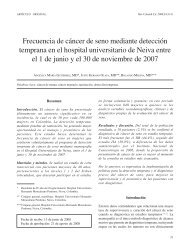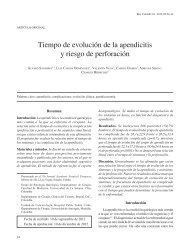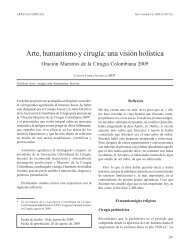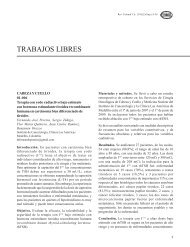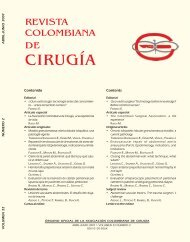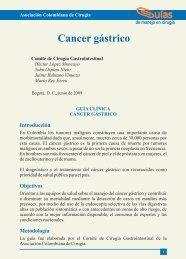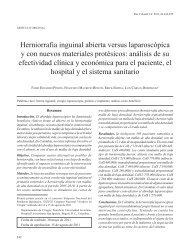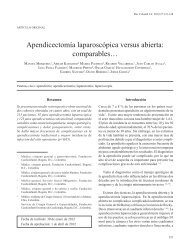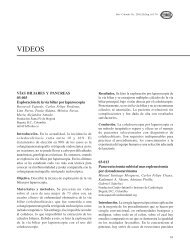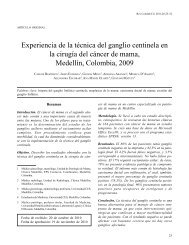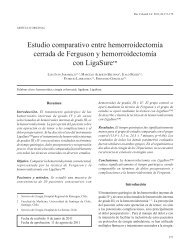Evaluación de las escalas ISS y NISS en trauma penetrante grave
Evaluación de las escalas ISS y NISS en trauma penetrante grave
Evaluación de las escalas ISS y NISS en trauma penetrante grave
You also want an ePaper? Increase the reach of your titles
YUMPU automatically turns print PDFs into web optimized ePapers that Google loves.
Gélvez S., Ordóñez C., Badiel M., et al. Rev Colomb Cir. 2009;24:229-35.<br />
Con este estudio se <strong>de</strong>muestra que el N<strong>ISS</strong> ti<strong>en</strong>e<br />
un mejor <strong>de</strong>sempeño como predictor <strong>de</strong> mortalidad<br />
que el <strong>ISS</strong> <strong>en</strong> el subgrupo <strong>de</strong> paci<strong>en</strong>tes con laparotomía<br />
conv<strong>en</strong>cional no <strong>de</strong> control <strong>de</strong> daños <strong>en</strong> <strong>trauma</strong><br />
p<strong>en</strong>etrante, pero no <strong>en</strong> laparotomía <strong>de</strong> control <strong>de</strong><br />
daños.<br />
A<strong>de</strong>más, se <strong>en</strong>contró que <strong>las</strong> esca<strong>las</strong> tuvieron un<br />
<strong>de</strong>sempeño subóptimo <strong>en</strong> laparotomía <strong>de</strong> control <strong>de</strong><br />
daños. Este segundo resultado es la razón por la cual los<br />
esfuerzos <strong>de</strong>b<strong>en</strong> ir <strong>en</strong>caminados hacia la búsqueda <strong>de</strong><br />
un índice que combine tanto el daño anatómico como el<br />
fisiológico, para lograr una mejor predicción <strong>de</strong> la<br />
mortalidad <strong>en</strong> casos <strong>de</strong> <strong>trauma</strong> p<strong>en</strong>etran <strong>grave</strong> que<br />
requier<strong>en</strong> laparotomía <strong>de</strong> control <strong>de</strong> daños como única<br />
opción <strong>de</strong> tratami<strong>en</strong>to inicial ante la <strong>grave</strong>dad <strong>de</strong> sus<br />
lesiones.<br />
Es necesario realizar mayores esfuerzos para<br />
i<strong>de</strong>ntificar nuevos factores pronóstico <strong>en</strong> paci<strong>en</strong>tes con<br />
<strong>trauma</strong> <strong>grave</strong> y críticam<strong>en</strong>te <strong>en</strong>fermos.<br />
Evaluation of the <strong>ISS</strong> and N<strong>ISS</strong> injury severity scores in pati<strong>en</strong>ts<br />
with severe p<strong>en</strong>etrating <strong>trauma</strong><br />
Abstract<br />
Introduction. Despite the wi<strong>de</strong> use of <strong>ISS</strong> as a mortality predictive score in <strong>trauma</strong>, several reports have<br />
shown that <strong>ISS</strong> is a poor predictor of outcome especially in pati<strong>en</strong>ts with severe p<strong>en</strong>etrating injuries. More<br />
rec<strong>en</strong>tly, the use of New <strong>ISS</strong> (N<strong>ISS</strong>) has be<strong>en</strong> compared with <strong>ISS</strong> in blunt severe <strong>trauma</strong> and mild p<strong>en</strong>etrating<br />
<strong>trauma</strong>. The purpose of this study was to evaluate the performance of N<strong>ISS</strong> and <strong>ISS</strong> in pati<strong>en</strong>ts with severe<br />
p<strong>en</strong>etrating <strong>trauma</strong>, both in damage control (DC) and not damage control (no-DC) surgery.<br />
Methods. Consecutive adult pati<strong>en</strong>ts with p<strong>en</strong>etrating <strong>trauma</strong> and surgery were i<strong>de</strong>ntified over a 6-years<br />
period (2003-2008) in our prospective <strong>trauma</strong> single c<strong>en</strong>ter registry (DAMACON). N<strong>ISS</strong> was estimated<br />
retrospectively. Logistic regression was used to construct ROC curves and areas un<strong>de</strong>r the curve (AUC) in<br />
or<strong>de</strong>r to compare the discriminative capacity among scores by type of surgical approach.<br />
Results. A total of 214 pati<strong>en</strong>ts with p<strong>en</strong>etrating <strong>trauma</strong>, 93 (%) nee<strong>de</strong>d DC surgery. Mean age for DC group<br />
was of 32.3±10 years old, RTS was 6.2±1.9, and 30 days mortality was of 35.5%. Compared with non-DC<br />
pati<strong>en</strong>ts with mean age of 30.3±10.9 years old, RTS was 7.1±1.2 and 30 days mortality of 3.3%. N<strong>ISS</strong> and<br />
<strong>ISS</strong> AUC were 0.86 and 0.72 respectively (P=0.01), for non-DC group; and 0.71 and 0.76 in DC group.<br />
Conclusion. N<strong>ISS</strong> showed an improved performance for mortality prediction over <strong>ISS</strong> in the subgroup of<br />
pati<strong>en</strong>ts with non-DC surgery for p<strong>en</strong>etrating <strong>trauma</strong>, but not in DC setting. Furthermore, overall performance<br />
of the scores was sub-optimal in this setting. More efforts have to be ma<strong>de</strong> to i<strong>de</strong>ntify new prognostic factors<br />
for this subgroup of very ill pati<strong>en</strong>ts.<br />
Key words: wounds and injuries; <strong>trauma</strong> severity indices; injury severity score; mortality.<br />
Refer<strong>en</strong>cias<br />
1. DELLINGER EP. Use of scoring systems to assess pati<strong>en</strong>ts with<br />
surgical sepsis. Surg Clin North Am. 1988;68:123-45.<br />
2. CHAMPION HR., SACCO WJ., GAINER PS., PATOW SM. The effect<br />
of medical direction on <strong>trauma</strong> triage. J Trauma. 1988;28:235-9.<br />
234



